Itō Shinsui 伊東 深水 (1898–1972 ) was a master Japanese painter and printmaker specializing in bijin-ga “images of beautiful women” and fūkei-ga “landscapes.” His prints are emblematic of the Shin-hanga “New Prints” movement, a revival of the ukiyo-e tradition in early 20th century Japan.
Shinsui was born in Tokyo with the name Itō Hajime. He began his artistic training in 1910, at age 12, in the drawing department of the Tokyo Printing Company before joining the workshop of the painter, illustrator and essayist, Kiyokata Kaburaki (1878–1972). As a pupil of ukiyo-e master, Yoshitoshi Tsukioka (1839–92), Kiyokata’s atelier traced its lineage back to traditional ukiyo-e genre, which had a significant influence on the young generation of New Print artists such as Shinsui. The young Shinsui developed an interest in nihonga “Japanese-style” painting and continued his artistic training in the evenings while working as an illustrator at the Tokyo Printing Company. He quickly gained recognition for his technical acumen, winning prizes for his oil paintings at the exhibition of the Southwest Painting Society, Tokyo in 1912, first Japan Art Institute Exhibition in 1914, and annual Ministry of Education Exhibition in 1915.
Shinsui’s intimate depiction of an elegant, young woman in traditional dress styling her hair, Before the Mirror, attracted the attention of prominent publisher and proponent of New Prints, Watanabe Shōsaburō (1885–1962) who was introduced to the artist through Kiyokata. Watanabe convinced Shinsui to design works for woodblock prints, beginning with a version of Before the Mirror in 1916. This marked the beginning of a 45-year collaboration that lasted until Watanabe’s death in 1962. Together, the artist and publisher collaborated on over 160 print designs, whose subject matter consisted primarily of landscapes and beautiful women. Often compared to the work of Utagawa Hiroshige (1797–1858), Shinsui’s series Eight Views of Lake Biwa (1917–1918) revived interest in landscape prints and inspired other artists including another Kiyokata pupil Hasui Kawase (1883–1957) and Yoshida Hiroshi (1876–1950). Although tied to earlier ukiyo-e depictions of courtesans, his first set of bijin-ga, Twelve Figures of New Beauties (1922–23) and two installments of Series of Modern Beauties (1929-1931 and 1931-1936) were often reworked from his paintings. These private, often voyeuristic scenes of women attending to their appearance displayed grace and sensuality through a use of bold color and keen attention to the details of modern fashion.
While he is best known in the West for his prints, Shinsui is widely accepted as one of the most accomplished painters of beautiful women in Japan. The artist built on this reputation as a master of bijin to establish the Shinsui Academy of Japanese-style painting in 1927 (renamed the Academy of the Clear Peak in 1930) where he trained subsequent generations of painters in the nihon-ga style. He utilized a variety of formats including albums, hanging scrolls, and folding screens on both paper and silk. He also used his influence among the art establishment to found several societies dedicated to promoting realism in portraiture.
From the late 1930s and into the 1940s, Shinsui produced a number of notable landscape series including Twelve Views of Oshima (1937) and three installments of Sketches from the South (1943), based on visits as an official war artist in the Japanese Navy to colonies in China and elsewhere in 1939. During World War II, Shinsui evacuated to Nagano Prefecture in northwestern Japan where he completed his last major series Ten Views of Shinano (1948). While he remained a well-respected, active member of art circles in postwar Japan, he designed only a few additional prints after his wartime experiences. His work Tresses (1953), for example, was published by the Japanese government to mark his designation as a Bearer of Intangible Cultural Properties by the Japanese Agency for Cultural Affairs in 1952, the corresponding contemporary designation of Living National Treasure.
In addition to his designation as a Bearer of Intangible Cultural Properties (1952), Shinsui was appointed to the Japan Art Academy (1958) and received the Order of the Rising Sun (1970). Shinsui’s work is part of major collections around the world, including Los Angeles County Museum of Art, Metropolitan Museum of Art, New York, Museum of Fine Arts, Boston, Museum of Fine Arts, Houston, the British Museum, National Museums of Modern Art, Tokyo and the Tokyo National Museum.








 Japan
Japan







